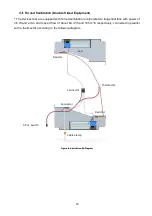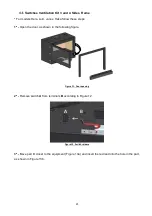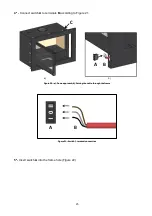
27
5. Instructions for Use
Attention:
all
regulations and standards must be complied with when installing this unit.
Fuel
* Only firewood should be used in this type of unit. It may not be used as an incinerator, nor should
other materials such as coal, painted wood, varnishes, thinners, liquid fuels, glues or plastics be used.
Also avoid burning common combustible materials such as cardboard and straw.
* The firewood should have a low water content (less than 20%) in order to ensure efficient combustion
and avoid creosote build-up in the smoke duct and on the glass.
* See Table 2, which lists some of the types of wood that can be used in these units.
Table 2 - List of types of firewood that may be used in SOLZAIMA fires, their geographical distribution and calorific value/reactions
Common
Name
Scientific
Name
Distribution
Characteristics
Smoke
Heat
Lighting
Combustion
Speed
Hardness
Pine
Pinus
Europe, except Finland;
Northern Sweden and
Norway.
Little
High
Easy
Fast
Soft
Cork Oak (+)
Quercus
suber
Southern Europe
Little
Very High
Easy
Regular
Hard
Eucalyptus
Eucalyptus
Mediterranean Region
Lot
Regular
Difficult
Slow
Hard
Holm Oak (+)
Quercus ilex
Southern Europe
Little
Very High
Difficult
Slow
Hard
Olive tree
Olea
Mediterranean Region
Little
Very High
Difficult
Slow
Hard
Oak
Quercus
Across Europe
Little
High
Difficult
Slow
Hard
Ash
Fraxinus
Across Europe
Regular
High
Difficult
Slow
Hard
Birch
Bétula
Across Europe
Little
Very High
Easy
Fast
Soft
Beech
Fagus
Europe, except Iberian
Peninsula and Northern
Europe, including
United Kingdom.
Little
High
Difficult
Slow
Hard
Elm
Ulmos
Across Europe
Regular
High
Difficult
Slow
Hard
Maple
Acer
Across Europe
Little
Regular
Regular
Slow
Soft
Poplar
Populus
Across Europe
Little
High
Easy
Fast
Soft
Chestnut
Castanea
Across Europe
Regular
High
Difficult
Slow
Hard
(+):
greatest commercial availability
















































